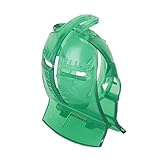Victorinox Swiss Army Golftool Pocket Knife with Pouch

Product Description
The locking divot repair tool easily slides forward to replace divots in the grass. When an implement is in use, the other tools retract into the handle for a comfortable grip. The groove cleaner blade can be used for both clearing the club head grooves and for punching the tee position, especially useful when the ground is hard or frozen.
Like all Swiss Army Knives, the GolfTool has a lifetime warranty, stainless steel implements and Swiss-made quality and durability.
Includes 10 Functions:
- One-Hand Locking Divot Repair Tool
- Ball Marker
- Tee Punch with
- – Groove Cleaner
- – Bottle Opener
- – Nail File
- Blade
- Tweezers
- Toothpick
- Scissors
History and Heritage
In 1884, Master Cutler Karl Elsener opened a cutlery shop in Ibach, Switzerland. There, he and the cutlers’ union he formed produced the finest steel cutlery, finished with the now-famous proprietary edge preferred globally by professional and home cooks. In 1891, Karl supplied the Swiss Army with its standard issue Soldier’s Knife and in 1897 with the Officer’s Knife. In 1921, after the death of his mother, Victoria, and with the advent of stainless steel, then known as “inoxydable"" and used in the production of his cutlery, Karl changed the name of the company to Victorinox. It is from those humble beginnings that a worldwide icon was born.
Today, Victorinox is still owned and operated by the Elsener family, and both the company and family still resides in the small village of Ibach, Switzerland.
Care Tips for Swiss Army Knives
The various tools are manufactured from high-quality steel with precisely tuned features that are essential for the particular application. The steel is tempered, annealed and polished to achieve the necessary hardness and provide optimum resistance to corrosion.
Sharpening
To re-sharpen your knife, use a whetstone at an angle of 15°– 20°. This will result in a cutting angle of 30°– 40°. If sharpening on a grinding wheel, always cool with plenty of water to avoid excessive temperatures and the resulting damages that may occur.
Cleaning
After you’ve used your Swiss Army Knife for all of its various applications, such as cutting open numerous boxes, you may notice that the blades begin to stick together. Opening and closing the blades in warm water several times will allow the tools to easily move again. Once they have dried, it is recommended, to apply a small drop of oil between the blade or tool shank and the spring. To optimally maintain the locking mechanism, periodically apply a drop of our recommended Swiss Army Knife Oil. Never put Swiss Army Knives in the dishwasher.
Amazon.com
About Swiss Army Knives
In 1884, Swiss cutler Karl Elsener set up shop in Ibach-Schwyz, installing a waterwheel in Tobelbach Brook to run his grinding and polishing machines. Thus began what would become the international brand name Victorinox, a combination of Victoria, for Elsener's mother, and "inox," or stainless steel. Today, Victorinox produces watches, luggage, clothing, and, famously, Swiss Army Knives. The original product dates to 1897, when Elsener patented the Swiss Officer's and Sports Knife he supplied to the Swiss Army. Following World War II, American servicemen and women shopping in PX stores shortened the name to Swiss Army Knife, which lives on in English-speaking countries around the world and has become a metaphor for versatility.





